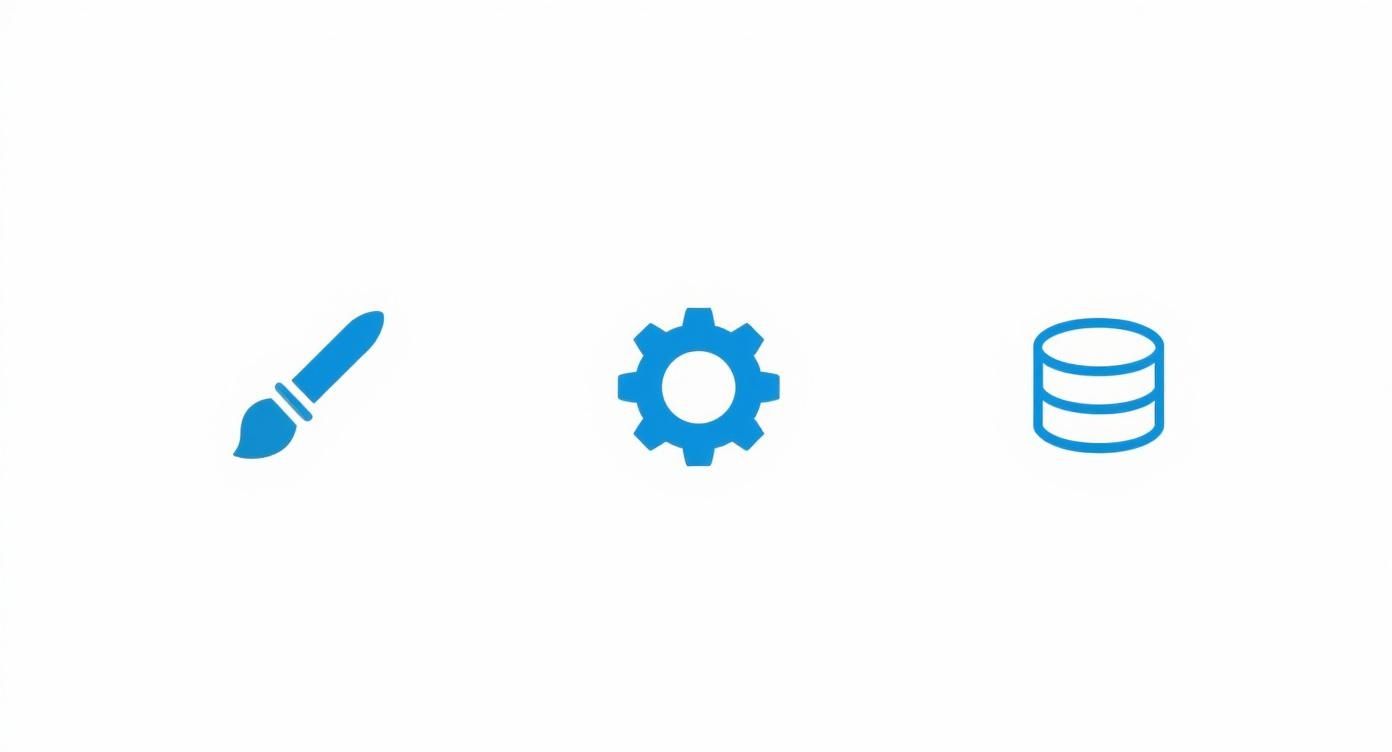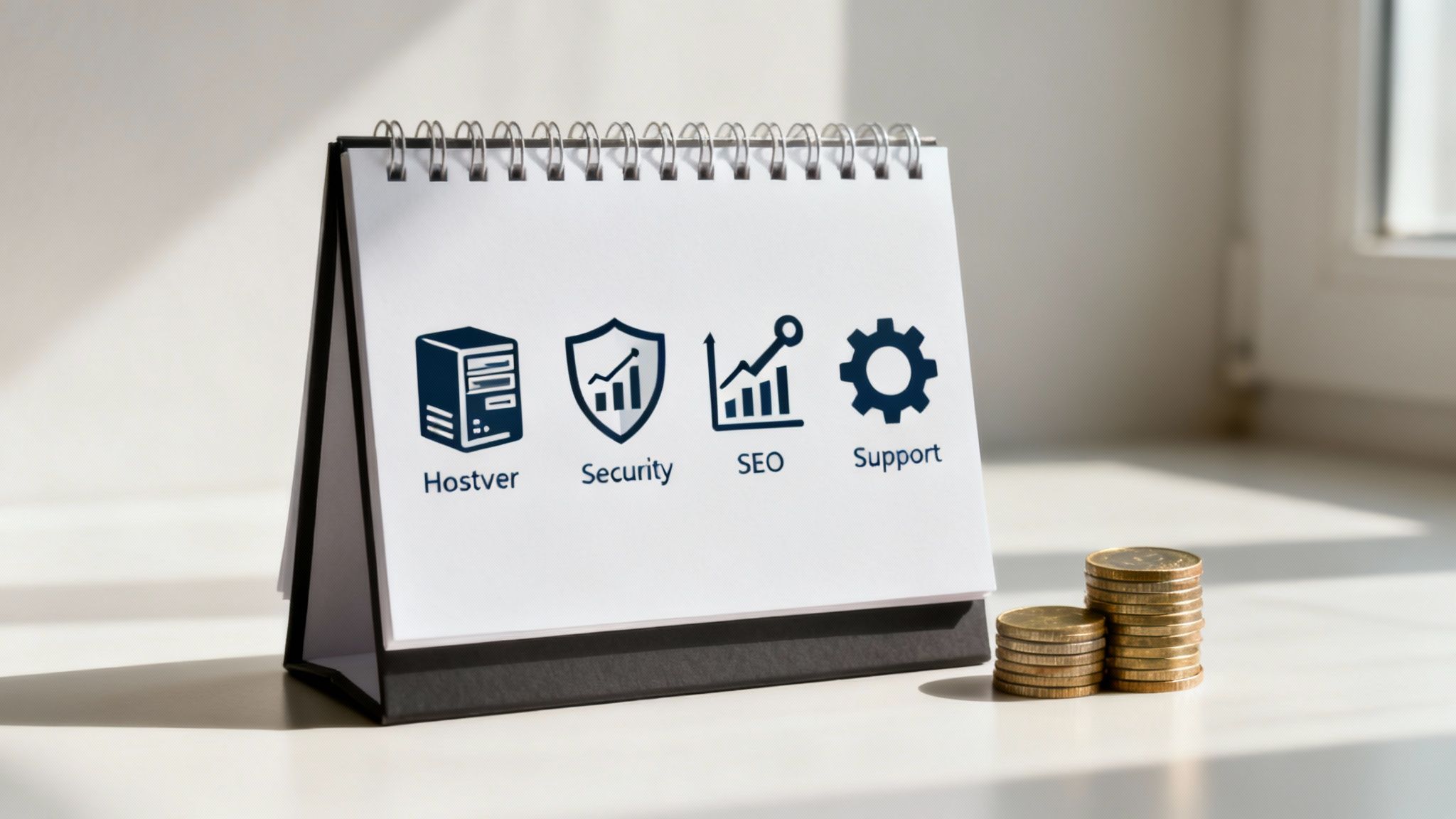How much does website development cost in 2026: prices and influencing factors
How much does it cost to develop a website? We hear this question all the time, and the best analogy we have is construction. How much does it cost to build a house? It all depends on the project. A small summer cottage (a business card site) can cost from $400, while a large shopping mall (a complex online store or web application) will run $10,000 and up.
The final amount is not just a price list figure. It is made up of dozens of small and large details: from the uniqueness of a design created from scratch to complex features developed specifically for you.
What actually determines a website’s cost

Before we dive into specific numbers, it’s important to understand the main principle. The price of website development is not a fixed store tag, but a flexible estimate. Every project is unique.
Back to our construction analogy. A single‑story house (a landing page) requires far fewer resources than a large shopping mall (an e‑commerce store). Every additional feature—whether an online payment system, a client dashboard, or a CRM integration—is like adding a new floor or laying complex utilities. All of this directly affects the final price.
Indicative price ranges
So you can at least roughly orient yourself, here are some starting figures. In our agency, the current pricing is as follows: in 2026, creating a simple business card website in Ukraine can cost from UAH 130,000 to 150,000. A corporate website will start from UAH 130,000 to 180,000. A freelancer may do this cheaper—about UAH 10,000–15,000 for a business card site and UAH 15,000–25,000 for a corporate site. However, you should consider the risks of working with a freelancer: possible delays, quality not meeting expectations, and limited post‑project guarantees, especially after full payment.
To make it even more concrete, we’ve prepared a table with approximate prices and timelines for the most popular website types.
Approximate cost of different website types at the Moveiton agency
| Website type | Approx. cost (UAH) | Development time |
|---|---|---|
| Landing Page | from 2000$ | from 2 weeks |
| Corporate website | from 3000$ | from 1 month |
| Online store (E‑commerce) | from 7000$ | from 2 months |
| Web app / Unique site / SaaS | from 4000$ | from 3 months |
| Turnkey CRM/ERP development | from 5000$ | from 1 month |
It’s important to understand that these figures are only a starting point. Next, we’ll break down what each amount consists of, which factors increase the budget the most, and how not to overspend so your website investment pays off as quickly as possible.
Key factors that affect the final price
There’s no single clear answer to “how much does it cost to make a website?”. Think of price as a construction set composed of many separate blocks. Each block is a certain stage of work or a feature with its own cost. Let’s unpack these elements in more detail.
Understanding these factors will help you not only navigate agency proposals but also consciously manage your budget. You’ll decide what to economize on at the start and what is a critical investment for future success.
Design and UX/UI
The first thing your client sees is the design. But it’s not just a pretty “wrapper.” It’s the user interaction architecture (UX/UI) that either helps people quickly find what they need and place an order or makes them close the tab in frustration.
There are two main design approaches that differ drastically in cost:
- Template‑based design. Uses a ready‑made visual solution. The main advantages are speed and lower cost. The downside is your site may look like hundreds of others, and customization options are limited. It’s a good start for projects with a minimal budget.
- Unique (custom) design. A visual concept created from scratch specifically for your brand, audience, and business goals. A designer conducts research, creates prototypes, tests them, and only then delivers final mockups. This approach is much more expensive but guarantees uniqueness and maximum usability.
Think of a template as an off‑the‑rack suit. It can fit okay, but not perfectly. Custom design is a tailor‑made suit. It accounts for every nuance of your “figure” (business) and fits flawlessly.
Functionality and complexity
This is arguably the biggest budget driver. The more jobs your site must do, the more complex and time‑consuming development becomes. A simple multi‑page blog and a complex online store are projects in completely different weight classes.
Here are just a few examples of functionality that significantly increases the cost:
- User account (dashboard). Requires registration, authentication, data storage, and order history logic.
- Payment gateway integration. Connecting online payments requires working with bank APIs, ensuring transaction security, and meeting compliance standards.
- Complex calculators or configurators. For example, service cost calculators, room furniture visualizers, or car configuration selectors.
- Integration with third‑party services. CRM, inventory systems, delivery services (e.g., Nova Poshta), etc. Each integration means extra developer hours.
The more such “bricks” your project includes, the higher the final estimate will be.
Content Management System (CMS)
A CMS (Content Management System) is essentially your site’s “admin panel.” It lets you add news, products, and edit page content without constantly involving developers. The CMS you choose affects both cost and flexibility.
Main options:
-
Popular open‑source CMS (WordPress, Joomla). The most common choice for many projects. They have abundant plugins and themes, which reduces development cost. They’re flexible and supported by large communities. For a detailed comparison, see our article which CMS is better — WordPress or Joomla.
-
Custom‑built CMS. Created from scratch for your project. It’s the most expensive option, chosen for large portals or web apps with unique logic where standard solutions don’t fit.
-
CMF Atom. Our own CMF (Content Management Framework) Atom is built on the open‑source CodeIgniter 4 platform (meaning its code is available for modification and use by other developers). This allows any developer to support the site in the future without our agency. Our sites are more expensive than those built on off‑the‑shelf CMSs because the admin system is developed entirely for you and your needs. We offer built‑in modules for easy page editing (page manager), lead tracking, and numerous security methods since we work with major Ukrainian banks. This significantly speeds up development, and the admin system is extremely easy to use compared to solutions like WordPress, Joomla, or Opencart. Building on a CMF is more cost‑effective and secure than using ready‑made solutions or writing your own custom CMS, which is the longest and not always the safest route (many critical bugs can be introduced).
Responsive layout
Today, over 60% of internet traffic comes from mobile devices. If your site is inconvenient to view on a smartphone, you’re simply losing a huge portion of potential customers. Responsive layout makes your site “adapt” to any screen size—from small phones to large monitors.
This has long been an industry standard rather than an add‑on. The cost of responsiveness is usually included in the overall estimate, but complexity can vary. Ensuring a perfect look across all devices takes additional front‑end time, which affects the final price.
How much a website costs: a breakdown by type
Now that we’ve covered the general budget factors, let’s get specific. The question “how much does a website cost” always comes down to its type. That’s logical: each project requires a different toolset and scope of work, which shape the final price.
To make it clear what you’re paying for and what numbers to expect, let’s look at four of the most popular categories.
Landing Page
A landing page is the “sniper” of the website world. It has one very specific goal: persuade a visitor to take a target action—leave a request, subscribe to a newsletter, or download a price list. It’s an ideal tool for quickly launching ad campaigns, testing a new niche, or selling a specific product or service.
Although it’s a single page, its development requires meticulous craftsmanship. Every section, headline, and button must work toward the goal.
What’s usually included in the price:
- Unique design: Visuals that resonate with your audience and match your brand style.
- Sales copywriting: Persuasive messaging and clear calls to action (CTAs).
- Responsive layout: Flawless display on smartphones and tablets.
- Form setup: Integrating lead forms so requests go straight to your email or CRM.
Approximate cost: from 90 000 UAH.
Corporate website
If a landing page is a sniper, a corporate website is your full‑fledged online presence. It has a more complex structure and solves several tasks at once: describing services in detail, building brand trust, attracting new clients, and even aiding recruitment.
Such a site typically includes key sections:
- Home
- About
- Services (or catalog)
- Blog (or news)
- Contacts
Any additional page—portfolio, testimonials, or an online calculator—increases the scope of work and thus the budget. It’s also a solid base for ongoing SEO. For small businesses wanting a concise presentation, a business card site is a suitable lightweight alternative.
Approximate cost: from 130 000 UAH.
Here, price is strongly affected by design complexity, functionality, and the chosen CMS.

As you can see, functionality and the CMS choice are no less significant price components than design itself.
Online store (E‑commerce)
Building an online store is top‑tier work. It’s not enough to present products nicely. You must build the entire online commerce cycle—from finding products to payment and delivery selection.
The biggest cost drivers include:
- Product catalog: Logical structure, easy navigation, informative product cards with photos, descriptions, and specs.
- Filtering and search: Letting shoppers find items quickly by price, brand, size, or other parameters.
- Cart and checkout: An intuitive customer journey that won’t make them abandon the purchase.
- Payment integration: Connecting popular online payment services (e.g., LiqPay, WayForPay).
- Delivery service integration: Automatic cost calculation and carrier selection (e.g., Nova Poshta).
The rule is simple: the more products, the more complex the filters, and the more integrations, the higher the cost.
Approximate cost: from 300 000 UAH.
Web application or SaaS platform
This is the most complex—and naturally the most expensive—category. A web application (or SaaS—Software as a Service) is a full‑fledged software product running in the browser that solves specific business tasks. Examples include online editors, CRMs, booking systems, or learning platforms.
The key difference here is custom business logic. Almost every element is built from scratch for the client’s unique processes.
The high cost is driven by:
- Complex architecture and robust databases.
- Development of unique features with no equivalents in off‑the‑shelf solutions.
- Integrations with third‑party services via APIs for data exchange.
- Heightened security and performance requirements.
Such projects are always estimated individually after a deep requirements analysis.
Approximate cost: from 250,000 UAH and can easily reach into the millions.
Turnkey CRM/ERP development
Building your own CRM or ERP system is a major step for a business seeking greater efficiency and security. Your own system helps avoid perpetual subscription fees—you pay once for development, and later only for functionality updates as needed.
Developing such systems on our CMF Atom provides high data protection and performance, which is crucial for any company. Integration with existing business processes happens smoothly thanks to detailed customization to the client’s unique requirements.
Approximate cost: from 250,000 UAH.
How the choice of contractor affects the budget
Once you have a clear idea of the site type and functionality, an equally important question arises: who will bring your idea to life? Choosing a contractor is not just finding available hands. It’s a strategic decision that directly determines how much website development will cost, the quality you get, and how quickly it starts working for you.
It’s very similar to construction. For a small room renovation, you can call a handyman. To build an entire house, it’s better to hire a construction company. The approaches, costs, and guarantees will be completely different. Let’s consider three main routes: freelancers, web agencies, and website builders.
Freelancers: flexibility bordering on risk
Freelancers are independent specialists easy to find on marketplaces or via referrals. This is perhaps the most affordable option, especially for simple tasks like a landing page or a small brochure site.
Why choose freelancers?
- Attractive price: Their services are often noticeably cheaper than an agency’s. They have no office, managers, or large team overhead.
- Flexibility: It’s easier to arrange small changes “on the fly” or non‑standard terms.
- Direct contact: You communicate directly with the performer, which can speed up issue resolution.
However, serious risks lurk behind the appeal. A freelancer is one person. They can get sick, lose motivation, or simply disappear. Often they’re strong in one area (e.g., design) but weak in another (e.g., front‑end). For a complex project, you’ll need to assemble a “dream team” of several freelancers and coordinate them yourself.
Web agencies: comprehensive approach and solid guarantees
A web agency like Moveiton is a well‑coordinated team where multiple specialists work on your project simultaneously: a project manager, designer, developers, QA, and often a marketer and SEO specialist. It’s the best choice for medium and large projects: corporate portals, e‑commerce stores, and web services.
An agency is your general contractor in the web world. You set the task; they handle everything—from planning to launch and support. You get a single point of contact, contractual legal guarantees, and confidence in the outcome.
Yes, agency services cost more. But you’re paying not for “hours” but for expertise, established processes, and reliability. It’s an investment in a stable, predictable result that won’t fall apart in six months.
Website builders: a quick DIY start
Builders like Wix, Tilda, or Shopify are online platforms that let you assemble a site yourself from ready‑made blocks, like Lego. It’s an ideal DIY solution for those with a very limited budget but time and willingness to learn.
This option is attractive due to minimal upfront costs. In Ukraine, paid builder plans can range from UAH 200 to 15,000 per month, depending on the functionality you need. You can find more about pricing in our detailed overview of website creation costs.
But it’s important to understand what you’re paying for:
- Template nature: Your site will look similar to thousands of others on the same platform.
- Limitations: You can’t add a unique feature if the builder doesn’t support it.
- Vendor lock‑in: You’re fully tied to the service. You can’t migrate such a site to your own hosting.
Comparing website contractors
To put everything in order and help you choose wisely, here’s a brief comparison table.
| Criteria | Freelancer | Agency | Website builder |
|---|---|---|---|
| Price | Low | High | Minimal (subscription) |
| Speed | Medium (depends on one person) | High (team‑based) | Highest (hours to launch) |
| Quality | Unstable (depends on performer) | High and predictable | Basic, template‑based |
| Support | Limited, no guarantees | Comprehensive, contractual | Platform support |
| Flexibility | High | Medium (within the scope) | Low (platform limits) |
| Reliability | Low | High (legal guarantees) | High (platform responsibility) |
As we can see, choosing a contractor is always about balancing your budget, quality requirements, and risk tolerance. For simple tasks or idea testing, a freelancer or builder may suffice. But if you’re aiming for a serious business tool that will grow with your company, a web agency is the reliable partner.
Hidden and ongoing costs after launch

Launching a site is like buying a car. The car itself is only the initial investment. To keep it running, you need fuel, inspections, and occasional repairs. The same applies to a website: development is only the first step, not the finish line.
Many focus on “how much website development costs” but forget what comes next. And then come regular, equally important expenses. These “hidden” budget items ensure stability, security, and effectiveness of your online business. Ignore them, and your initial investment may go to waste.
Let’s break down the ongoing costs you should expect after launch so you can budget long‑term and avoid unpleasant surprises.
Hosting and domain name
These are the two pillars that keep your site online. Imagine you’re building a house: you need a plot of land (hosting) and a unique address (domain) so people can find you.
- Domain name is your site’s address, e.g.,
yourcompany.com.ua. It must be renewed annually. It typically costs $10–30 per year, depending on the TLD (.com, .ua, .store, etc.). - Hosting is renting server space where your site’s files physically reside. Without it, no one will see anything at your address.
Hosting can range from $5 to $50 per month or more, depending on the type (shared, VPS, dedicated), storage, and performance your project needs.
Cutting corners on hosting is like building a beautiful house on a shaky foundation. Slow pages, frequent outages, and weak protection against attacks are the real price of such “savings.” It drives customers away and hurts search rankings.
Technical support and updates
A modern site is a living organism, not a static brochure. To keep it healthy, fast, and secure, it needs regular maintenance. This expense line is often underestimated.
Professional website technical support is your guarantee of stability and peace of mind.
What’s usually included:
- CMS and plugin updates. WordPress and other CMS vendors constantly release updates that not only add features but also patch security vulnerabilities.
- Backups. Regular backups are your insurance against failure, malware, or human error, enabling quick restoration with minimal loss.
- Uptime monitoring. 24/7 services check whether your site is up. If it goes down, the support team is alerted and acts immediately.
- Malware scans. Proactive threat detection helps prevent hacks and protect your customers’ data before trouble strikes.
Such services can cost from $50 to $500 per month, depending on project complexity. This is an investment in your business’s uninterrupted operation.
SEO and digital marketing
Great, your site is ready! What’s next? If nobody knows about it, it won’t bring any clients. A site without visitors is like a store in the middle of a desert. To attract people, you need ongoing marketing investment.
Be prepared: this is often the largest expense category and can exceed the development cost.
Typical spending areas:
- SEO (Search Engine Optimization). A long‑term game. A set of activities to make Google love your site and rank it higher. This includes competitor analysis, technical optimization, content and link work. SEO budgets usually start from $700–1000 per month.
- PPC (Paid search). Google Ads for immediate results—ideal for getting the first clients right after launch. You pay per click, and the budget depends on your ambitions.
- Content marketing. Regular blog posts, case studies, and how‑tos. Quality content brings organic traffic and, more importantly, builds brand trust.
- SMM (Social media marketing). Promoting your brand on platforms like Facebook, Instagram, or LinkedIn to reach your audience where they spend time.
So when you ask yourself “how much does website development cost,” add these three key categories to the budget. They transform your site from a mere brochure into a revenue‑generating tool.
Frequently asked questions about website development cost
When a business is ready to build a website, the first question is always the same: “How much will it cost?” That’s perfectly logical. But behind this simple question lies a world of details that shape the final price.
Our goal here is to clear the fog and give straight answers to the questions we hear most often. Understanding these nuances helps you not only learn the price but also plan a budget that works—without unpleasant surprises.
Why do different studios quote such different prices?
You’ve likely seen this: you send the same brief for a corporate site and get quotes of $500 from some and $5000 (or more) from others. That’s not a scam—it reflects completely different approaches to the work.
- Team experience. A studio with a portfolio of complex projects and seasoned specialists values its time higher. You’re paying not just for code but for expertise that ensures your project doesn’t get stuck due to unforeseen technical issues.
- Depth of discovery. A cheap offer often means the team will take your spec and “build to picture.” Pricier agencies start with business, market, and competitor analysis. They create not just a website but a tool tailored to your specific goals.
- Technology. You can assemble a site on a ready WordPress theme or build a custom solution on modern frameworks. The latter costs more but offers a different level of speed, security, and flexibility for future growth.
Simply put, a low price is often just a facade without a deep foundation of business logic. A higher price is an investment in a reliable platform that will serve you for years and be ready to scale.
Can we start small and improve later?
Yes—and it’s one of the smartest approaches. In development it’s called an MVP (Minimum Viable Product). The idea is not to pour a huge budget into a site with every feature you can imagine.
Instead, you launch a basic version that solves your customer’s main problem.
For an online store, this might be a simple catalog of 10–20 key products with orders handled by a manager. This lets you go to market quickly, get initial sales, and—most importantly—collect real feedback.
Based on that data, you decide where to go next: connect online payments, expand the catalog, or build a user account. This approach makes your investment highly targeted.
What does “turnkey website” include, and what do I get?
“Turnkey website” sounds great, but every agency means something slightly different. Our definition is a full cycle of work that delivers a 100% ready‑to‑use business tool. You won’t need to find a copywriter to fill pages or another specialist for setup.
A standard turnkey package from a professional studio usually includes:
- Analysis and planning: Information architecture and wireframes.
- Design: A unique visual style aligned with your brand.
- Development: Front‑end, back‑end, and CMS integration.
- Basic content population: We place your texts and photos on key pages.
- QA testing: Thorough checks across devices and bug fixes.
- Launch: Migration to your hosting and domain setup.
- Training: Teaching your staff to use the admin panel so you can update content yourself.
Always clarify the details. Does it include copywriting? Basic SEO? Analytics setup? The more is spelled out in the contract, the fewer surprise charges later.
How long until the site is ready?
Time, like money, is critical. The timeline depends on project complexity and your communication speed. If you provide materials promptly and sign off stages quickly, the process moves much faster.
Approximate timelines:
- Landing page: 2–4 weeks.
- Corporate website: 2–3 months.
- E‑commerce: 3–4 months.
- Web application: 3+ months.
- Turnkey CRM or ERP: from 1 month.
Projects most often stall due to slow content delivery (texts, photos) or lengthy internal design approvals on the client side. Tip: prepare materials in advance and appoint one responsible person to communicate with the dev team. This saves weeks.
We hope this clarifies how much website development costs and what drives the final amount. If you’re ready to go from theory to practice and get a detailed estimate for your project, the Moveiton team is at your service. We’ll help turn your idea into a profit‑generating tool.
Learn more about our services and request a consultation at moveiton.net.
